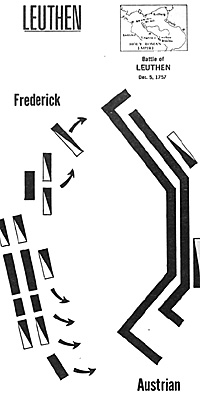 There it was revitalized by Frederick the Great of Prussia who had already unsuccessfully tried it at the battles of Kolin and Rossbach. Facing Prince Charles' Austrian army of 72,000 with his own force of only 43,000, Frederick first faked an attack against the enemy's right, thereby
forcing the Austrians to commit troops at a point where there would be no battle. Then while under the partial cover of the terrain, he advanced his battalions obliquely or in echelon, towards the Austrian left.
There it was revitalized by Frederick the Great of Prussia who had already unsuccessfully tried it at the battles of Kolin and Rossbach. Facing Prince Charles' Austrian army of 72,000 with his own force of only 43,000, Frederick first faked an attack against the enemy's right, thereby
forcing the Austrians to commit troops at a point where there would be no battle. Then while under the partial cover of the terrain, he advanced his battalions obliquely or in echelon, towards the Austrian left.
An age-old plan was thus being put into action. As Frederick himself wrote, still conscious of the tactical errors which he had committed at Prague and Kol in, he aimed ''to strike the hardest with his right and to refuse the left. " During this diagonal (cadence-stepped) march, an observor wrote "It was a beautiful sight. The heads of the columns were constantly on the same level ... as if in a review." History was about to repeat itself.
As at Leuctra, the attacker outnumbered his victim four to one at point of contact. The Austrian line, too overextended to recover with support for the overwhelmed flank, was rolled up and routed in less than three hours. Another "oblique-order" battle had been won.
While Frederick's oblique order instantly became the darling "new" tactic of Europe, it was never used again. Napoleon, who called it "a masterpiece of movements, manoeuvres, and resultion, "occasionally used it as a formation for maching his corps d'armee but never as a specified tactical weapon. The oblique line thus quietly bowed out of the conduct of war.
- EDITOR'S NOTE
Maybe it wasn't used successfully, but it was tried! During the American Civil War it was particularly popular among Confederate generals--most of which were brought up on Jomini's studies of Napoleon's methods, where the oblique order was rated highly. Examples include the battles of Seven Pines, Gaines's Mill, Frazier's Farm, Malvern Hill, Gettysburg (the second day), Chickamauga (where, with a lot of luck helping, it worked!), and Peach Tree Creek. D.S.L.
Briefly now, what can we summarize about the oblique line? First we can see that the oblique order of battle was always used by an attacker who was numerically inferior to his adversary. Second, it was always directed against one end of an over-extended line. Offensively therefore it was designed to bring the most against the least as quickly as possible. Defensively it could potentially seal itself off from any rearward attack. We have however no record of its use in this latter way.
Although limited in use, the oblique line may have also contributed toatype of flank-mindedness inmilitary thought. Offensively, outflanking one's opponent is a proven tactic. This very manouevre in fact at the Battle of Salamanca by Wellington when he sent Packenham to smash and to turn the advancing French left was labeled by the French general Foy as an example of Frederick's famous "oblique order. "
In truth it was not but Foy's remark still reveals that the oblique order was part of a military commander's thought some 55 years after its last use. As a last point, concern about a refused portion of one's own forces may have had some effect on the evolution of a reserve system as well as simple protection of a flank. In any case the oblique line did its work when it was called upon even though its placeinthe history books is relatively obscure. Now it's time to lift the tactic from the printed page and the world of real conflict to see if it can be applied to the gameboard.
Bibliography
The Battles of Frederick the Great by Thomas Carlyle (1904)
Great Captains by T. A. Dodge (1889)
The Great Duke by Arthur Bryant (1970)
The Campaign of Gaugamela by E. W. Marsden (1970)
War through the Ages by Lynn Montross (1944)
The Cyropaedia by Xenophon
More Oblique Line
Back to Table of Contents -- Panzerfaust #56
To Panzerfaust/Campaign List of Issues
To MagWeb Master Magazine List
© Copyright 1972 by Donald S. Lowry.
This article appears in MagWeb (Magazine Web) on the Internet World Wide Web.
Other military history articles and gaming articles are available at http://www.magweb.com